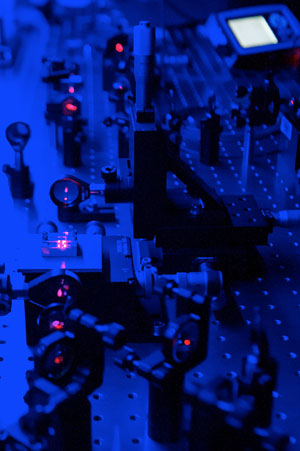| Sep 28, 2019 | |
Light in a new light(Nanowerk News) In a paper published in Nature's NPJ Quantum Information ("Multiphoton quantum-state engineering using conditional measurements"), Omar Magaña-Loaiza, assistant professor in the Louisiana State University (LSU) Department of Physics & Astronomy, and his team of researchers describe a noteworthy step forward in the quantum manipulation and control of light, which has far-reaching quantum technology applications in imaging, simulation, metrology, computation, communication, and cryptography, among other areas. |
|
 |
|
| Source of entangled photons. A lens is used to focus the pump beam onto the non-linear crystal, the generated entangled photons are collected by a second lens and then sent to a polarizing beam splitter. This is utilized to direct entangled photons to different ports of the source. Photons with different polarizations emerge through different output ports. The red laser in the polarizing beam splitter is utilized for alignment purposes. (Image: Elsa Hahne/ORED) | |
| At the quantum level, light remains difficult to control for engineering purposes. | |
| "If we're able to control photon fluctuations and associated noise," Magaña-Loaiza said. "Then, we can make more precise measurements. This technology is new and will change our field." | |
| Physicists all over the world are racing to develop techniques to preserve light's quantum properties at large enough scales for practical purposes. While physicists can so far control the quantum properties of single photons and pairs of photons, leading to powerful applications through entanglement and "heralding" (wherein knowledge of one photon gives relatively certain knowledge about another, not-yet-detected photon), Magaña-Loaiza's team successfully demonstrated a method to generate groups of photons with these same powerful properties--known as multiphoton states. | |
| By subtracting out some photons, Magaña-Loaiza said, "We can reshape the form of the wavepacket and artificially increase the number of photons in it." | |
| Moreover, whereas previous scientists produced multiphoton states using multiple sources, Magaña-Loaiza's team managed to build a single source to produce multiphoton packets that share similarities with entangled lasers: a major technological achievement. | |
| But perhaps most impressively, the publication reveals that Magaña-Loaiza's team can generate multiple kinds of light with manipulable quantum states in one single setup. | |
| "I really think we're doing something new, and I think people are starting to recognize this," he said. | |
| In addition to generating single photons, they can also produce entangled laser light and entangled natural light (i.e., sunlight) with desired properties. | |
| "If you're able to manipulate light at this fundamental level you can engineer light," he said. |
| Source: Louisiana State University | |
|
Subscribe to a free copy of one of our daily Nanowerk Newsletter Email Digests with a compilation of all of the day's news. |
